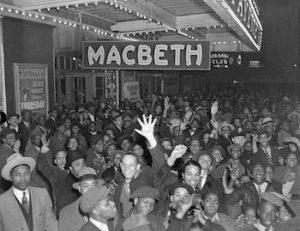
Voodoo Macbeth
*Voodoo Macbeth opened on this date in 1936. This play was a New York William Shakespeare's Macbeth production through the Federal Theatre Project.
Orson Welles adapted and directed the show, moved the play's setting from Scotland to a fictional Caribbean Island, and recruited an entirely Black cast. It earned the nickname for his production from the Haitian vodou that fulfilled the role of Scottish witchcraft. A box office sensation, the production was a landmark theatrical event for several reasons: its innovative interpretation of the play, its success in promoting black theatre, and its role in securing the reputation of its 20-year-old director.
Before the production opened, the Harlem Communists tried to agitate the community against the project, wrongly believing that Welles had cast black actors to create a comic or burlesque version of Shakespeare. The theatre was picketed throughout rehearsals. One man attempted to slash Welles's face with a razor, but Canada Lee, a former boxer, stopped him. According to Welles, the anger was suddenly replaced "for no reason at all" by widespread excitement and pride in the community as the opening night approached.
The "Voodoo Macbeth" defied all expectations, becoming a box office sensation. Seventh Avenue had to be closed for ten blocks on either side of the theatre on opening night. Most reviewers, including those from The New York Times and the New York Daily News, loved the production, praising its energy and excitement. However, Carter was criticized for poor verse delivery and seeming more interested in displaying his physique than acting. One reviewer, Percy Hammond of the Herald Tribune, was negative about the entire cast, accusing the actors of being inaudible and timid.
In response, one African drummer created a voodoo doll of Hammond, stuck pins in it, and encouraged Welles to take responsibility for any torments Hammond suffered. Welles says he found this amusing until Hammond died shortly afterward.